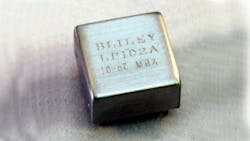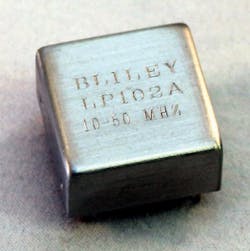OCXO Trims Phase Noise and Power Consumption
Minimizing power consumption is vital to many applications where the power supply is limited, such as in portable and/or battery-based electronic devices. Saving power, however, can be costly in terms of performance for some components. Oven-controlled crystal oscillators (OCXOs), for instance, can exhibit degraded stability and phase noise at lower power levels.
Fortunately, the model LP102 OCXO from Bliley Technologies is designed for outstanding stability and phase noise, all the while consuming a mere 135 mW power during steady-state operation. The OCXO is available with sinewave or HCMOS outputs (with 10-ns rise/fall time) at frequencies from 10 to 50 MHz, and with initial accuracy if ±10 ppb.
OCXOs such as the model LP102 (see figure) are critical to maintaining frequency stability and precise timing in analog and digital circuits and systems. The basic design achieves excellent crystal resonator stability with changes in temperature by maintaining the crystal in a temperature-controlled enclosure. The penalty for enhanced temperature stability is the increased power consumption required to control the temperature of the crystal chamber.
As expected, the LP102 consumes an increased amount of power during startup (350 mW) when it must stabilize the temperature of the crystal chamber. Once this is accomplished, however (typically in one minute or less), the steady-state power consumption is only 135 mW—remarkably low for an OCXO of any kind, as they are usually rated in terms of watts of power consumption.
The LP102 in no way compromises its performance for the low power consumption. The phase noise performance is specified separately for sinewave and HCMOS outputs, as well as for two different temperature ranges.
By way of example: For sinewave outputs from -20 to +70°C, the static phase noise is typically -95 dBc/Hz offset 1 Hz from the carrier, -125 dBc/Hz offset 10 Hz, -162 dBc/Hz offset 1 kHz, and -165 dBc/Hz offset 10 kHz. For sinewave outputs from -40 to +85°C, the phase noise is typically -90 dBc/Hz offset 1 Hz from the carrier, -120 dBc/Hz offset 10 Hz, -158 dBc/Hz offset 1 kHz, and -162 dBc/Hz offset 10 kHz.
For HCMOS outputs from -20 to +70°C, the static phase noise is typically -95 dBc/Hz offset 1 Hz from the carrier, -125 dBc/Hz offset 10 Hz from the carrier, -152 dBc/Hz offset 1 kHz from the carrier, and -155 dBc/Hz offset 10 kHz from the carrier. For the wider temperature range of -40 to +85°C, the phase noise drops to -90 dBc/Hz offset 1 Hz, -120 dBc/Hz offset 10 Hz, -150 dBc/Hz offset 1 kHz, and also -150 dBc/Hz offset 10 kHz from the carrier.
Harmonic levels are -30 dBc or better, while spurious levels are -60 dBc or better. The LP102 low-power OCXO features 0.5 ppb/g acceleration sensitivity. It delivers +9 dBm output power into a 50-Ω load. The OCXO incorporates electronic frequency control for adjustments over a total frequency range of ±0.5 ppm and 10% tuning linearity.
The oscillator is designed for power supplies of +3.3 V dc ± 5% and +5.0 V dc ± 5% and an operating temperature range of -40 to +85°. Different grades of performance are available, such as frequency stability of ±25, 50, 75, or 100 ppb from -20 to +70°C and ±75 or 100 ppb from -40 to +85°C.
Bliley Technologies, 2545 W. Grandview Blvd., Erie, PA 16506; (814) 838-3571
Looking for parts? Go to SourceESB.
About the Author
Jack Browne
Technical Contributor
Jack Browne, Technical Contributor, has worked in technical publishing for over 30 years. He managed the content and production of three technical journals while at the American Institute of Physics, including Medical Physics and the Journal of Vacuum Science & Technology. He has been a Publisher and Editor for Penton Media, started the firm’s Wireless Symposium & Exhibition trade show in 1993, and currently serves as Technical Contributor for that company's Microwaves & RF magazine. Browne, who holds a BS in Mathematics from City College of New York and BA degrees in English and Philosophy from Fordham University, is a member of the IEEE.

